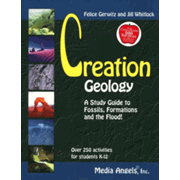Media Angels publishes science unit studies as well as a guide to creating your own such studies. The guide, Teaching Science and Having Fun! is optional, but I have reviewed it as a resource for those who prefer creating their own studies, especially those who are interested in science experiments and labs in the home. Read that review by clicking here: Teaching Science and Having Fun! The educational philosophy of this book is reflected in all Media Angels science books.
Creation Science Study Guides
 This is a series of unit study guides titled, Creation Science: A Study Guide to Creation, Creation Anatomy: A Study Guide to the Miracles of the Body!, Creation Astronomy: A Study Guide to the Constellations, and Creation Geology: A Study Guide to Fossils, Formations, and the Flood!
This is a series of unit study guides titled, Creation Science: A Study Guide to Creation, Creation Anatomy: A Study Guide to the Miracles of the Body!, Creation Astronomy: A Study Guide to the Constellations, and Creation Geology: A Study Guide to Fossils, Formations, and the Flood!
This series very much reflects what I think science education should look like with its combination of real books, experiments, and other interesting activities that truly engage children in the study of science.
Each study should take about six to eight weeks to complete. The guides are set up for multi-grade teaching with activities divided into levels for K-3, 4-8, and 9-12.
These are actually unit studies that stretch beyond science, although they do not provide complete coverage of any of the other subjects. Activities for each level are divided under the headings of Science Activities and Experiments, Geography/History, Reading Ideas List, Vocabulary/Spelling List, Vocabulary/Spelling/Grammar Ideas, Language Arts Ideas, Math Reinforcements, and Art/Music Ideas. Science receives the most attention, with a good deal of background information for the teacher included in a Teaching Outline section in each guide. Read through this section in each guide before you begin to teach the unit.
Lots of extras are included in each guide although these vary from guide to guide. The newest editions have added complete lesson plans and extensive, annotated bibliographies of resources on each topic. The suggested books are a mixture of non-sectarian and Christian titles.
I want to particularly highlight Creation Science: A Study Guide to Creation since this is a unique course that might be foundational to your other science studies. The first part of the guide presents information to support a young-earth, creationist viewpoint as well as the problems with Darwinian theory. Lessons include study of the book of Genesis along with activities, reading, and investigation. While younger students might participate in hands-on activities (like experimenting with a prism) that help them learn about God's creation, older students might create an experiment to demonstrate sedimentary erosion (p.65) or “Write an argument against the earliest people being unintelligent, slow, and not very clever” (p. 118). Or you might read aloud as a family a book such as Noah's Ark and the Ararat Adventure by John Morris with up-to-date information about clues to the location of Noah's ark. This is a great study for the whole family to enjoy together.
All of the guides are loaded with activity suggestions—hands-on activities, experiments, reading, research, and writing. However, I think you will also want to use the Experiment and Activity Packs that complement the books. These, too, are available in either print or downloadable PDF files for $12.95 each. While there are separate packs for each of the Creation Astronomy and Creation Anatomy books, there is a single pack to be used with both Creation Science and Creation Geology.
These packs feature reproducible pages of activities and experiments with step-by-step instructions, questions, games, puzzles, a glossary, and more. Many of the pages are suitable for students to use to create notebooks. Experiments are most appropriate for the elementary grades up through junior high since they do not require any of the mathematical analysis necessary for high school courses. Activity instructions in the packs are fairly well spelled out—they are much more than lists or outlines of suggestions.
For both the guides and the packs you need to plan ahead to determine which activities to do and what resources you will need. All studies are presented from a young-earth perspective and rely on a literal interpretation of the Bible. Otherwise, the religious perspective is generically Christian rather than Protestant or Catholic.











